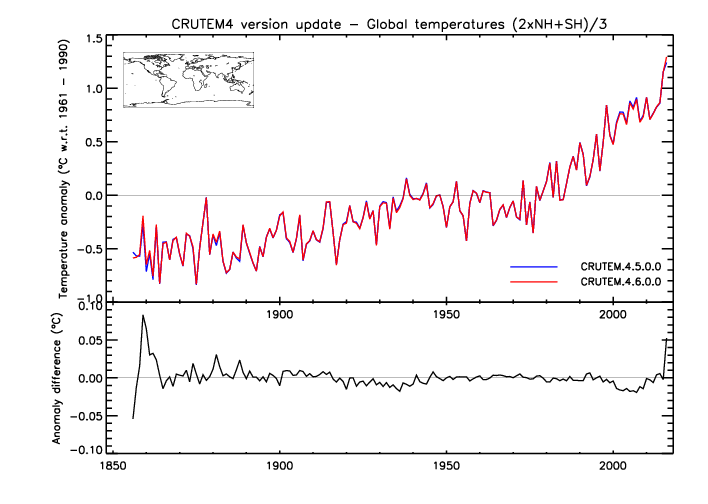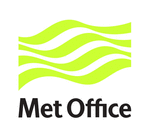
| Met Office Hadley Centre observations datasets |
| > Home > CRUTEM4 > Versions > |
This page describes updates in CRUTEM4 version CRUTEM.4.5.0.0. Previous versions of CRUTEM4 can be found here. Data for CRUTEM.4.5.0.0 can be found here.
Principal changes to the CRUTEM archive (post-CRUTEM.4.4.0.0), within the period April 2015 to June 2016 are listed below:
A number of Taiwanese series (ca. 30) have been downloaded from their website at http://www.cwb.gov.tw/V7e/climate/monthlyData/mD.htm. The series downloaded generally start in 2006. Most of the series were used to update those existing in the CRUTEM archive. In addition, two CRUTEM series were updated via personal communication with contacts at CMA (China).
Some long held Tmean series in the Climatic Research Unit were selected from an archive last used in the 1990s - many of which had originally come from GHCNv2 (https://www.ncdc.noaa.gov/ghcnm/v2.php) . The selection process looked for largely new (to CRUTEM) and sufficiently long series (to generate 1961-90 normals). A further search criterion required that the series came from parts of the world where large subsets of homogenized climate series are not already available. Potential inclusions were updated, where possible, using data from GHCNv3 (https://www.ncdc.noaa.gov/ghcnm/v3.php). The search revealed a significant number of long series from Japan that would bolster the CRUTEM holdings of Japanese series.
The final number of series merged with CRUTEM was 375 and these come mainly from parts of Asia (137 series from Japan), Europe (mainly Turkey), Africa and South America.
Following an assessment of the CRUTEM holdings of Malaysian series, it was apparent that a number of series received via a CD-ROM produced by ASEAN nations (The ASEAN Compendium of Climate Statistics - monthly data, funded by the Government of Japan) had not been merged with CRUTEM. In addition, a number of Malaysian series from the Colonial dataset (http://www.ncdc.noaa.gov/oa/climate/research/ghcn/colonialarchive.html), in conjunction with the ASEAN series, could now be matched with the ASEAN and other Malaysian holdings to produce long climate series.
There followed a two-stage merger, 66 Malaysian series were merged with CRUTEM and then 24 Colonial (Malaysian) series were merged.
Following on from the use of ASEAN series for Malaysia (as above), the processing and addition of ASEAN series from the CD-ROM was continued for all ASEAN national series present: Brunei, Cambodia, Indonesia, Laos, Malaysia, Myanmar, Philippines, Singapore, Thailand and Vietnam. Finally, 324 series (excluding Malaysia) were merged with CRUTEM.
Following personal communication with a member of the Israeli Met. Service (IMS), four series were merged with CRUTEM. The main gain here was the receipt of a new series for Jerusalem (WMO 40183), which compensates for the long Jerusalem Airport (40184) series that stopped reporting in 2000.
The availability of a prototype version of GHCNv4 (via personal communication), allowed the processing of the unadjusted series. Following extensive assessment and due to the prototype nature of GHCNv4, only a small number of new series were chosen to be included in CRUTEM at this point. The principal criteria for inclusion were that the series were from data-poor areas with particular attention to the high northern latitudes. 141 series were eventually merged with CRUTEM.
The annual update of USHCN series was run using data from (http://www.ncdc.noaa.gov/oa/climate/research/ushcn/daily.html). The file downloaded (ushcn.tavg.latest.FLs.52j.tar.gz) produced 1218 series for merger with CRUTEM (in line with similar exercises in recent years). Following this exercise, the post-merger series were assessed for "first reliable years" and a number of changes were made. Effectively, if there is any sign of inhomogeneity at the transition between any pre-USHCN section of a series (before the homogenized section begins) and the current USHCN series, the first-reliable-year is the first year of the USHCN homogenized series.
The current 'seven' homogenized climate series were received from NIWA (National Institute of Water and Atmospheric Research, https://www.niwa.co.nz/), through personal communication. Due to changes and updates made by NIWA to their climate series, a rationalization of the New Zealand series held in CRUTEM was necessary and this involved the removal of seven series.
The homogenized temperature series for Australia and some remote islands (including Antarctic stations) is available at http://www.bom.gov.au/climate/change/acorn-sat/#tabs=Data-and-networks. The most recent SAT (surface air temperature) series have been downloaded and merged with CRUTEM. The station network (120 in total) has remained the same as in recent years.
The temperature station series that have been made available by the LACA&D consortium (http://lacad.ciifen.org/) have been received and processed for inclusion in CRUTEM. The consortium provides data from Bolivia, Chile, Colombia, Ecuador, Peru, Suriname and Venezuela. The final number of series merged with CRUTEM was 21 from Suriname, Bolivia and Chile only.
Following the receipt and inclusion of 380 Chinese homogenized temperature series in 2013 (Xu et al., 2013: Homogenization of Chinese daily surface air temperatures and analysis of trends in the extreme temperature indices. JOURNAL OF GEOPHYSICAL RESEARCH: ATMOSPHERES, VOL. 118, 9708-9720, doi:10.1002/jgrd.50791), the authors have updated the series to the end of 2015 and these series have been received through personal communication. The updates have been added to CRUTEM.
An improved series for Grytviken (WMO ID code 88903) has been produced from various sources within the Climatic Research Unit. This single series has been merged with CRUTEM.
The SMHI (Swedish Meteorological and Hydrological Institute) climate data download facility (http://opendata-download-metobs.smhi.se/explore/) has been used to gain additional Swedish temperature series for CRUTEM. The main focus has been on high latitude locations with long series. The resulting merger involved 32 series from the web facility. In addition, two long and homogenized Swedish series in CRUTEM have been updated. These are the records for Stockholm (CRUTEM ID 24851) and Uppsala (CRUTEM ID 24581) - see http://onlinelibrary.wiley.com/doi/10.1002/(SICI)1097-0088(19970615)17:7%3C667::AID-JOC115%3E3.0.CO;2-J/abstract;jsessionid=6CDF5C3A590CB39DB93549DBC874B719.f03t03.
The Russian baseline air temperature dataset (http://meteo.ru/english/climate/temp.php) has updates to the end of 2015. These have been processed and merged with CRUTEM. The dataset is unchanged from recent years in terms of the station series present with 518 series.
The following diagnostic plots show comparisons of global and hemispheric time series for CRUTEM.4.5.0.0 (current version) and CRUTEM.4.4.0.0 (previous release).
AcknowledgementsFor this update of CRUTEM, the Climatic Research Unit was supported by the UK National Centre for Atmospheric Science (NCAS), a NERC collaborative centre, and by NERC through the SMURPHS project, grant NE/N006348/1. Commercial and media enquiriesYou can access the Met Office Customer Centre, any time of the day or night by phone, fax or e-mail. Trained staff will help you find the information or products that are right for you. |
 |
Maintained by: Colin Morice |
© Crown Copyright |